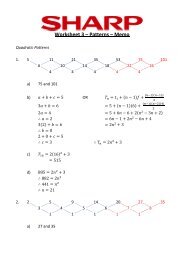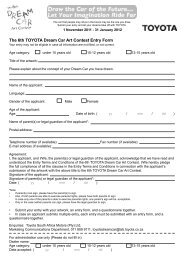curriculum and assessment policy statement (caps) - Department of ...
curriculum and assessment policy statement (caps) - Department of ...
curriculum and assessment policy statement (caps) - Department of ...
- No tags were found...
Create successful ePaper yourself
Turn your PDF publications into a flip-book with our unique Google optimized e-Paper software.
Content Area Content Clarification / Notes / Activities/Examples Recommended ResourcesApproximateDurationSuggested FormalAssessmentContinuedSemi-concrete using 2-D shapesLet the learners on the teachers instructions:‣ Place objects into groups that involve numbers 1 to 9 <strong>and</strong> count the objectsaloud.The teacher divides the learners into 5 groups.Let the learners:‣ Order <strong>and</strong> link the picture cards, the dot flash cards, the number symbols<strong>and</strong> the number names in the correct sequence up to the number 9 e.g.Picture<strong>of</strong> 1objectPicture<strong>of</strong> 2objectsPicture<strong>of</strong> 3objectsObjects in the classroom.5 sets <strong>of</strong> number cards that involvenumbers 1 to 9 for each group.Nine counters for each group.123onetwothreeetc.‣ Pack the correct number <strong>of</strong> counters on each dot card.Develop theconcepts <strong>of</strong> “morethan”, “less than”<strong>and</strong> “equal to”• Order <strong>and</strong> compare collections <strong>of</strong> objects using “more than/less than” <strong>and</strong> “equalto”Concrete using 3-D objects‣ The teacher provides a variety <strong>of</strong> objects such as leaves, stones, bottle<strong>caps</strong>, crayons, blocks, etc.Let the learners:‣ Sort them into “groups” e.g. all the stones together.‣ Count the amount <strong>of</strong> objects in each “group”.‣ Indicating which “group” is “more than”, “less than” <strong>and</strong> “equal to”.Sets that involve numbers up to 9:‣ Learners sit on the carpet <strong>and</strong> make two “nests” with the wool.‣ Teacher gives instruction to the learners to place 2 counters in onenest <strong>and</strong> 4 in the other nest.‣ Ask questions such as: “Which nest has “more than”, “less than” <strong>and</strong>the “same” number <strong>of</strong> counters?” e.g. the “nest” with 2 counters isless than the “nest” with 4 counters.Two pieces <strong>of</strong> wool for each learner9 counters for each learner1 day By the end <strong>of</strong> week 36assess <strong>and</strong> record whetherlearners can:Identify <strong>and</strong> underst<strong>and</strong> themeaning <strong>of</strong> the numbers 1 to9.Use <strong>and</strong> apply the number1 to 9 in familiar context.Ability to link the samenumber <strong>of</strong> objects to thenumber <strong>of</strong> pictures <strong>and</strong>dots.Continued‣ Form “more than, less than” <strong>and</strong> ‘equal” sets with numbers up to 9.Recognise <strong>and</strong> identify thenumber symbol <strong>and</strong>number name that involvenumber 1 to 9.103 | P age
















